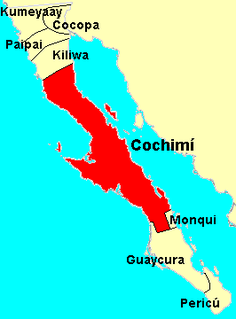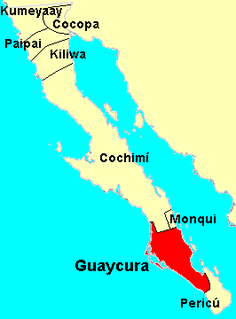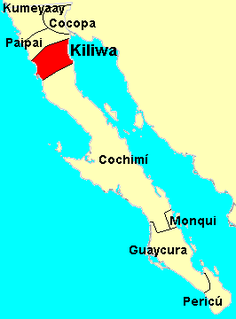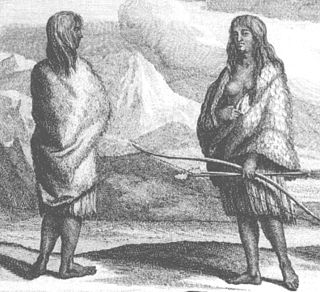 W
WAcaxee was a tribe or group of tribes in the Sierra Madre Occidental in eastern Sinaloa and NW Durango. They spoke a Tarachatitian language in the Southern Uto-Aztecan language family. Their culture was based on horticulture and the exploitation of wild animal and plant life. They are now extinct as an identifiable ethnic group.
 W
WThe Caxcan were a partly nomadic indigenous people of Mexico. Under their leader, Tenamaztle, the Caxcan were allied with the Zacatecos against the Spaniards during the Mixtón Rebellion in 1540-42. During the rebellion, they were described as "the heart and the center of the Indian Rebellion". After the rebellion, they were a constant target of the Zacatecos and Guachichiles due to their ceasefire agreement with the Spaniards. Their principal religious and population centers were at Teul, Tlaltenango, Juchipila, and Teocaltiche.
 W
WChichimeca is the name that the Nahua peoples of Mexico generically applied to nomadic and semi-nomadic peoples who were established in present-day Bajio region of Mexico. Chichimeca carried the same sense as the Roman term "barbarian" to describe Germanic tribes. The name, with its pejorative sense, was adopted by the Spanish Empire. For the Spanish, in the words of scholar Charlotte M. Gradie, "the Chichimecas were a wild, nomadic people who lived north of the Valley of Mexico. They had no fixed dwelling places, lived by hunting, wore little clothes and fiercely resisted foreign intrusion into their territory, which happened to contain silver mines the Spanish wished to exploit." In spite of not having temples or idols, they practiced animal and human sacrifice, and they were feared for their expertise and brutality in war.
 W
WThe Coahuiltecan were various small, autonomous bands of Native Americans who inhabited the Rio Grande valley in what is now southern Texas and northeastern Mexico. The various Coahuiltecan groups were hunter-gatherers. First encountered by Europeans in the sixteenth century, their population declined due to imported European diseases, slavery, and numerous small-scale wars fought against the Spanish, criollo, Apache, and other Coahuiltecan groups. The survivors were absorbed into the Hispanic and mestizo population of southern Texas or northern Mexico.
 W
WThe Cochimí were the aboriginal inhabitants of the central part of the Baja California peninsula, from El Rosario in the north to San Javier in the south.
 W
WThe Cocopah, also Cucapá, are Native Americans who live in Baja California and Sonora, Mexico, and in Arizona in the United States.
 W
WThe Guachichil, Cuauchichil, or Quauhchichitl, are an Indigenous people of Mexico. Pre-contact, they occupied the most extensive territory of all the indigenous Chichimeca Nations tribes in pre-Columbian Central Mexico.
 W
WThe Guamare people were an indigenous people of Mexico, who were established mostly in Guanajuato and at the border of Jalisco. They were part of the Chichimecas, a group of a nomadic hunter-gatherer culture and called themselves Children of the Wind, living religiously from the natural land. As a tradition, they would cremate their dead and spread their ashes into the wind back to 'Mother Earth'. The Guamare people were politically united with the Chichimeca Confederation, but like other Chichimeca nations were independent. The Chichimeca were established in the present-day Bajio region of Mexico.
 W
WThe Guarijío are an indigenous people of Mexico. They primarily live in 17 villages near the West Sierra Madre Mountains in Chihuahua and the Sonoran border. Their homelands are remote and reached either on foot or horseback. Their traditional Guarijio language has about 4000 speakers.
 W
WThe Guaycura were a native people of Baja California Sur, Mexico, occupying an area extending south from near Loreto to Todos Santos They contested the area around La Paz with the Pericú. The Guaycura were nomadic hunter-gatherers. They are distinguished by a language unrelated to any other Native American language, indicating in the opinion of some linguists that their ancestry in Baja California dates back thousands of years.
 W
WThe Hia C-eḍ Oʼodham, also known as Areneños or Sand Papagos are a Native American peoples whose traditional homeland lies between the Ajo Range, the Gila River, the Colorado River, and the Gulf of California. They are currently unrecognized at both the state and federal level in the United States and Mexico, although the Tohono Oʼodham Nation has a committee for issues related to them and has land held in trust for them. They are represented by a community organization known as the Hia-Ced Oʼodham Alliance. The Hia C-eḍ Oʼodham are no longer nomadic, and the majority today live in or near Ajo, Arizona, or the small settlements of Blaisdell and Dome near Yuma.
 W
WThe Huichol or Wixárika are an indigenous people of Mexico living in the Sierra Madre Occidental range in the states of Nayarit, Jalisco, Zacatecas, and Durango. They are best known to the larger world as the Huichol, however, they refer to themselves as Wixáritari in their native Huichol language. The adjectival form of Wixáritari and name for their own language is Wixárika.
 W
WThe Kiliwa are an indigenous people of Mexico living in northern Baja California. Historically they occupied a territory lying between the Cochimí on the south and the Paipai on the north, and extending from San Felipe on the Gulf of California to San Quintín on the Pacific coast. Their traditional language is the Kiliwa language.
 W
WThe Mayo or Yoreme are an indigenous group in Mexico, living in the northern states of southern Sonora, northern Sinaloa and small settlements in Durango.
 W
WMogollon culture is an archaeological culture of Native American peoples from Southern New Mexico and Arizona, Northern Sonora and Chihuahua, and Western Texas. The northern part of this region is Oasisamerica, while the southern span of the Mogollon culture is known as Aridoamerica.
 W
WThe Monqui were indigenous peoples of Mexico, who lived in the vicinity of Loreto, Baja California Sur, Mexico, at the time of Spanish contact. Monqui territory included about 65 kilometres (40 mi) of coast along the Gulf of California and extended a few kilometers inland to where the Cochimi people lived.
 W
WThe Otomi are an indigenous people of Mexico inhabiting the central Mexican Plateau (Altiplano) region.
 W
WThe north Pame, or Xi'iuy, as they refer to themselves, the south Pame, or Ñáhu, Nyaxu, and the Pame in Querétaro or Re Nuye Eyyä, are an Indigenous people of central Mexico primarily living in the state of San Luis Potosí. When Spanish colonizers arrived and conquered their traditional territory in the sixteenth century, which "extended from the modern state of Tamaulipas in the north to Hidalgo and the area around Mexico City in the south along the Sierra Madre," they renamed "the area Pamería, and applied the name Pame to all of the peoples there."
 W
WThe Payaya people were Indigenous people whose territory encompassed the area of present-day San Antonio, Texas. The Payaya were a Coahuiltecan band and are the earliest recorded inhabitants of San Pedro Springs Park, the geographical area that became San Antonio.
 W
WThe Pericú were the aboriginal inhabitants of the Cape Region, the southernmost portion of Baja California Sur, Mexico. They have been linguistically and culturally extinct since the late 18th century.
 W
WThe Pima Bajo people are indigenous people of Mexico who reside in a mountainous region along the line between the States of Chihuahua and Sonora in northern Mexico. They are related to the Pima and Tohono O’odham of Arizona and northern Sonora, speaking a similar but distinct language.
 W
WThe Rarámuri or Tarahumara are a group of indigenous people of the Americas living in the state of Chihuahua in Mexico. They are renowned for their long-distance running ability.
 W
WThe Seri or Comcaac are an indigenous group of the Mexican state of Sonora. The majority reside on the Seri communal property, in the towns of Punta Chueca and El Desemboque on the mainland coast of the Gulf of California. Tiburón Island (Tahejöc) and San Esteban Island were also part of their traditional territory. They were historically seminomadic hunter-gatherers who maintained an intimate relationship with both the sea and the land. They are one of the ethnic groups of Mexico that has most strongly maintained their language and culture throughout the years after contact with Spanish and Mexican cultures.
 W
WThe Tecuexe were an indigenous peoples of Mexico, who lived in the eastern part of present-day Guadalajara.
 W
WThe Tepehuán are an indigenous people of Mexico. They live in Northwestern, Western, and some parts of North-Central Mexico. The indigenous Tepehuán language has three branches: Northern Tepehuan, Southeastern Tepehuan, Southwestern Tepehuan. The heart of the Tepehuan territory is in the Valley of Guadiana in Durango, but they eventually expanded into southern Chihuahua, eastern Sinaloa, and northern Jalisco, Nayarit, and Zacatecas. By the time of the Spanish conquest of Mexico, Tepehuan lands spanned a large territory along the Sierra Madre Occidental. Tepehuán groups are divided into the Ódami, Audam, and O'dam, each with their own language, culture, and beliefs.
 W
WThe Xixime were an indigenous people who inhabited a portion of the Sierra Madre Occidental mountains in the present day states of Durango and Sinaloa, Mexico. The Xixime are noted for their reported practice of cannibalism and resistance to Spanish colonization in the form of the Xixime Rebellion of 1610.
 W
WThe Yaqui or Hiaki or Yoeme are a Uto-Aztecan speaking indigenous people of Mexico who inhabit the valley of the Río Yaqui in the Mexican state of Sonora and the Southwestern United States. They also have communities in Chihuahua and Durango. The Pascua Yaqui Tribe is based in Tucson, Arizona. Yaqui people live elsewhere in the United States, especially California, Arizona and Nevada.
 W
WThe Zacatecos is the name of an indigenous group, one of the peoples called Chichimecas by the Aztecs. They lived in most of what is now the state of Zacatecas and the northeastern part of Durango. They have many direct descendants, but most of their culture and traditions have disappeared with time. Large concentrations of modern-day descendants may reside in Zacatecas and Durango, as well as other large cities of Mexico.